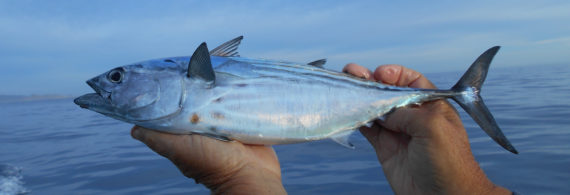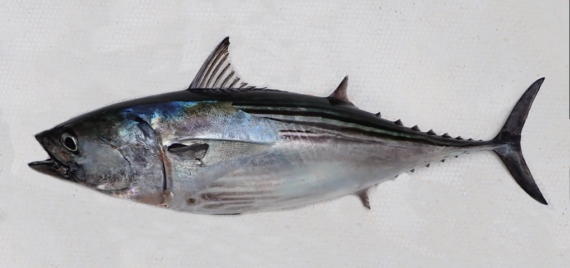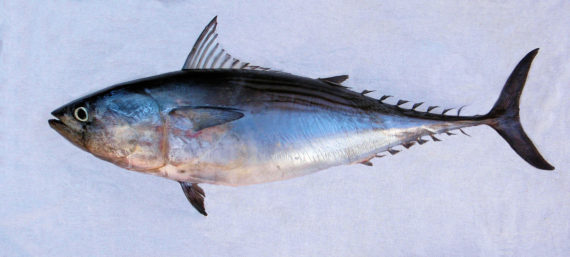Black Skipjack, Euthynnus lineatus
 Black Skipjack, Euthynnus lineatus. Fish caught from coastal waters off Point Palmilla, Baja California Sur, March 2018. Length: 36 cm (14 inches).
Black Skipjack, Euthynnus lineatus. Fish caught from coastal waters off Point Palmilla, Baja California Sur, March 2018. Length: 36 cm (14 inches).
 Black Skipjack, Euthynnus lineatus. Fish caught from coastal waters off Puerto Vallarta, Jalisco, February 2023. Length: 41 cm (16 inches). Catch and photograph courtesy of Ben Cantrell, Peoria, Illinois.
Black Skipjack, Euthynnus lineatus. Fish caught from coastal waters off Puerto Vallarta, Jalisco, February 2023. Length: 41 cm (16 inches). Catch and photograph courtesy of Ben Cantrell, Peoria, Illinois.
 Black Skipjack, Euthynnus lineatus. Fish caught from coastal waters off Point Palmilla, Baja California Sur, April 2015. Length: 90 cm (2 feet 11 inches).
Black Skipjack, Euthynnus lineatus. Fish caught from coastal waters off Point Palmilla, Baja California Sur, April 2015. Length: 90 cm (2 feet 11 inches).
 Black Skipjack, Euthynnus lineatus. Fish caught from coastal waters off Loreto, Baja California Sur, July 2019. Length: 92 cm (3 feet 0 inches). Catch, photograph and identification courtesy of Chris Wheaton, Fullerton, California.
Black Skipjack, Euthynnus lineatus. Fish caught from coastal waters off Loreto, Baja California Sur, July 2019. Length: 92 cm (3 feet 0 inches). Catch, photograph and identification courtesy of Chris Wheaton, Fullerton, California.
The Black Skipjack, Euthynnus lineatus, is one of the most common members of the Mackerel or Scombridae Family, that is known in Mexico as barrilete negro. Globally, there are three species in the genus Euthynnus, and all three are found in Mexican waters, one in the Atlantic and two in the Pacific Ocean.
The Black Skipjack has an elongated fusiform tuna-like body. They are dark blue dorsally and transition to silver ventrally. They have a patch of 5 or 6 horizontal stripes on their back that extend from the origin of their dorsal fin. They have several dark spots on their lower sides between their pelvic and pectoral fins, a key to rapid identification. They have mid-sized black eyes, and slender conical teeth. Their anal fin has 11 to 12 rays and 7 finlets; their caudal fin is large and crescent-shaped with 2 small keels separated by 1 large keel at the base; their first dorsal fin has 10 to 15 spines and is much larger than the second; and, their second dorsal fin has 10 to 15 spines and 9 finlets with anterior spines that are much longer giving the fin a strongly concave outline. They have 33 to 39 gill rakers. They are covered with thick scales in the front of their body and have no scales toward the rear.
The Black Skipjack is a pelagic species found in coastal waters at depths up to 40 m (130 feet) with water temperatures in excess of 23oC (73oF). They reach a maximum of 92 cm (3 feet 0 inches) in length and 11.8 kg (26 lbs) in weight. As of January 1, 2024, the International Game Fish Association world record for length stood at 69 cm (2 feet 3 inches) with the fish caught by my good friend Chris Wheaton within Magdalena Bay, Baja California Sur in November 2013. The corresponding world record for weight stands at 11.8 kg (26 lbs 0 oz) with the fish caught in coastal waters off the Thetis Bank, Baja California Sur in October 1991. They normally travel in small schools and at times form multi-species schools with Skipjack Tuna, Katsuwonus pelamis and Yellowfin Tuna, Thunnus albacares, being opportunistic predators. The Black Skipjack is poorly studied with very limited information available about their lifestyle and behavioral patterns including specific details on age, growth, longevity, movement patterns, diet, habitat use, and reproduction.
The Black Skipjack is a resident of all Mexican of all waters of the Pacific Ocean with the exception that they are absent from the extreme northern portions of the Sea of Cortez.
The Black Skipjack can be confused with the Kawakawa, Euthynnus affinis (12 oblique dark stripes on upper back that terminate under the dorsal fin, the Pacific Bonito, Sarda chiliensis (5 or 6 oblique dark stripes on upper back with no spots), the Striped Bonito, Sarda orientalis (8 to 11 horizontal broken lines on back with no spots), and the Skipjack Tuna, Katsuwonus pelamis (4 to 6 horizontal dark stripes on sides with no spots).
From a conservation perspective the Black Skipjack is currently considered to be of Least Concern, with stable widely distributed populations. They are not targeted by either commercial fishermen or recreational anglers. They are an incidental catch on live sardines, rapidly trolled feathers or hoochies, or off the bottom with chrome yo-yo irons. For their size they put up a horrific fight. Their meat of the adults is dark and they are viewed by locals as inedible. They are utilized as fly-lined bait fish, chunk bait, or cut bait for fishing down deep being the Number One cut bait for the heavily targeted Finescale Triggerfish. They are caught at a fairly high level in commercial purse seines.